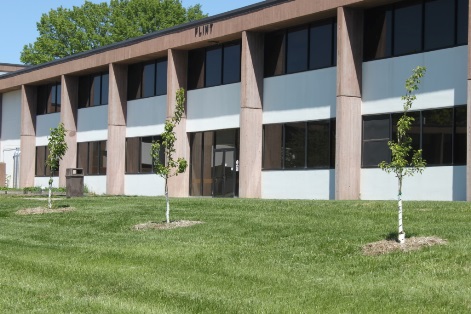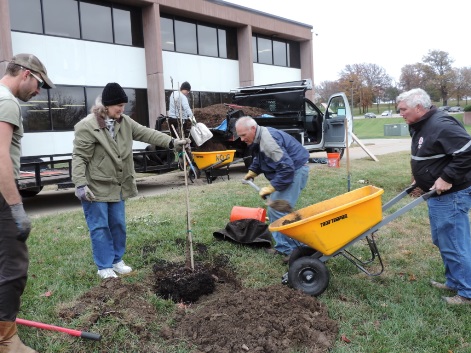
by Kelly Rogge, KCKCC
If you have been walking on the Kansas City Kansas Community College in the last few weeks, you might have noticed a new grove of trees between the Jewell Student Center and the Flint Building. This is KCKCC’s Giving Grove.
Penny Mahon, media and reference librarian at KCKCC and the chair of the college’s Sustainable Environments Committee, said after the committee learned about the purpose of a Giving Grove, they decided it was an important enough endeavor to bring to the college.
“The grove will provide food to our own students on campus, some of whom have limited access to fresh, healthy, local food. This might be done through our own food pantry or by other means, with any extra food passed on to employees and-or community members in need,” she said. “A requirement of obtaining a grove is for at least half of the food to be given to a group in need, and our students fill that requirement. The grove also collaborates with the Unified Government’s Healthy Communities Wyandotte program.”
Planted last fall, there are 13 trees in KCKCC’s Giving Grove. Choices were made based on hardiness, reliability, productivity, disease-resistance, and, of course, ability to thrive in the Greater Kansas City area. The grove includes four semi-dwarf apple, three Asian Pear, three Euro Pear and three Bush Cherry trees.
“We should get our first crop of fruit within three years,” Mahon said. “We have been requested to pick the blossoms off the trees for the first two years so that all of the growth goes into the trees themselves. Once beginning production, the trees should produce vast amounts of food for many years. Take for example that a single semi-dwarf apple tree can produce up to six tons of fruit over its three-decade lifespan.”
A program of the Kansas City Community Gardens, the Giving Grove provides educational assistance to community groups, children and low-income individuals throughout the Kansas City area in order to give them the skills to grow and produce their own food. The idea is to create edible tree gardens in the community and to work together to plant, grow, tend, harvest and share fresh produce. For more information about the program, visit www.givinggrove.org.
In the annual county health rankings report, Wyandotte County ranks near the bottom or very last in the state of Kansas. In addition, Wyandotte County has a food insecurity rate of 18 percent compared to the Kansas average of 16.5 percent. Food insecurity happens when people have limited or uncertain access to adequate food. Giving Groves such as the one at KCKCC help to alleviate some of that food insecurity and help community members live a healthier lifestyle.
Mahon said KCKCC’s Giving Grove has two stewards – herself and KCKCC science professor Curtis Smith, who are in charge of overseeing the grove from watering and pruning to fertilization as needed. Stewards must attend multiple training sessions with Kansas City Community Gardens before being qualified to maintain the grove. Buildings and Grounds have also assisted in watering the grove as well as the planting of the trees.
“The long-term goal is to take a bite out of obesity, improve food insecurity, reconnect people with growing, eating, tending, harvesting, using and sharing their own healthy food as well as to improve the health of and strengthen our greater KCKCC community by developing an edible tree garden,” Mahon said. “Edible tree gardening is a sustainable food production and land management system. In addition, the trees will sustain water, prevent erosion, and sequester, or capture carbon from the soil and so will help reduce the carbon footprint of the college, all while providing additional cover and food for the wildlife on campus.”
Kelly Rogge is the public information supervisor at KCKCC.

